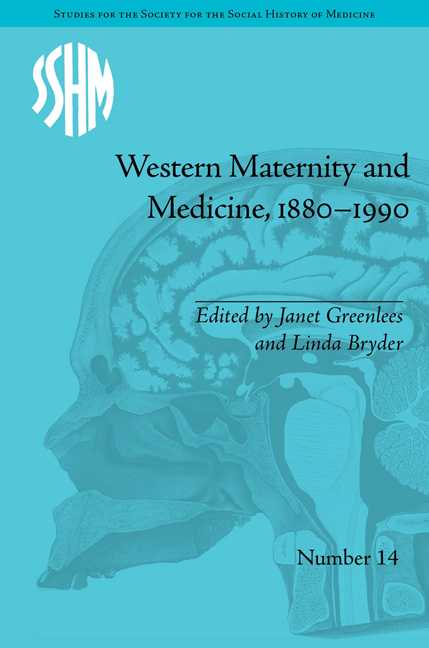Book contents
- Frontmatter
- CONTENTS
- Acknowledgements
- List of Contributors
- List of Tables
- Western Maternity and Medicine: An Introduction
- 1 Safely Delivered? Insights into Late Nineteenth-Century Australian Maternity Care from Coronial Investigations into Maternal Deaths
- 2 Pregnancy, Pathology and Public Morals: Making Antenatal Care in Edinburgh around 1900
- 3 ‘The Peculiar and Complex Female Problem’: The Church of Scotland and Health Care for Unwed Mothers, 1900–1948
- 4 Taking ‘Advantage of the Facilities and Comforts … Offered’: Women's Choice of Hospital Delivery in Interwar Edinburgh
- 5 ‘What Women Want’: Childbirth Services and Women's Activism in New Zealand, 1900–1960
- 6 'Twixt God and Geography: The Development of Maternity Services in Twentieth-Century Ireland
- 7 Test Tubes and Turpitude: Medical Responses to the Infertile Patient in Mid-Twentieth-Century Scotland
- 8 Women's Experiences of the Maternity Services in Berkshire and Oxfordshire, c. 1970–1990
- 9 From Muller to Johnson Controls: Mothers and Workplace Health in the US, from Protective Labour Legislation to Fetal Protection Policies
- Notes
- Index
9 - From Muller to Johnson Controls: Mothers and Workplace Health in the US, from Protective Labour Legislation to Fetal Protection Policies
- Frontmatter
- CONTENTS
- Acknowledgements
- List of Contributors
- List of Tables
- Western Maternity and Medicine: An Introduction
- 1 Safely Delivered? Insights into Late Nineteenth-Century Australian Maternity Care from Coronial Investigations into Maternal Deaths
- 2 Pregnancy, Pathology and Public Morals: Making Antenatal Care in Edinburgh around 1900
- 3 ‘The Peculiar and Complex Female Problem’: The Church of Scotland and Health Care for Unwed Mothers, 1900–1948
- 4 Taking ‘Advantage of the Facilities and Comforts … Offered’: Women's Choice of Hospital Delivery in Interwar Edinburgh
- 5 ‘What Women Want’: Childbirth Services and Women's Activism in New Zealand, 1900–1960
- 6 'Twixt God and Geography: The Development of Maternity Services in Twentieth-Century Ireland
- 7 Test Tubes and Turpitude: Medical Responses to the Infertile Patient in Mid-Twentieth-Century Scotland
- 8 Women's Experiences of the Maternity Services in Berkshire and Oxfordshire, c. 1970–1990
- 9 From Muller to Johnson Controls: Mothers and Workplace Health in the US, from Protective Labour Legislation to Fetal Protection Policies
- Notes
- Index
Summary
Alice Hamilton, the path-breaking woman who created the field of industrial toxicology in the United States at the beginning of the twentieth century, was also a physician, factory inspector, a professor at Harvard's School of Public Health and a lifelong part-time resident of Hull House, the Chicago settlement house started by Jane Addams. She was a progressive, and one of the early experts in industrial lead poisoning, travelling to various cities throughout the nation. And in 1917 she spoke about the effects of lead poisoning in women workers. Speaking before Pennsylvania's Industrial Welfare and Efficiency Conference, Hamilton praised the increased entrance of women into nontraditional jobs in industry, but expressed a popular reservation about such moves: ‘It will be no boon to women if it demands that they are to enter trades which are not fitted for them and do work which will injure their health’. Like many progressive reformers of the period, she was concerned about protecting the health of women in factories, but interestingly, she qualified her position:
I am myself in favor of employing women in all such work so long as the danger is not one to which her sex is peculiarly liable; so long as the danger is one which a man faces equally, I think there is no reason why a woman should not face it also.
- Type
- Chapter
- Information
- Western Maternity and Medicine, 1880–1990 , pp. 147 - 162Publisher: Pickering & ChattoFirst published in: 2014



